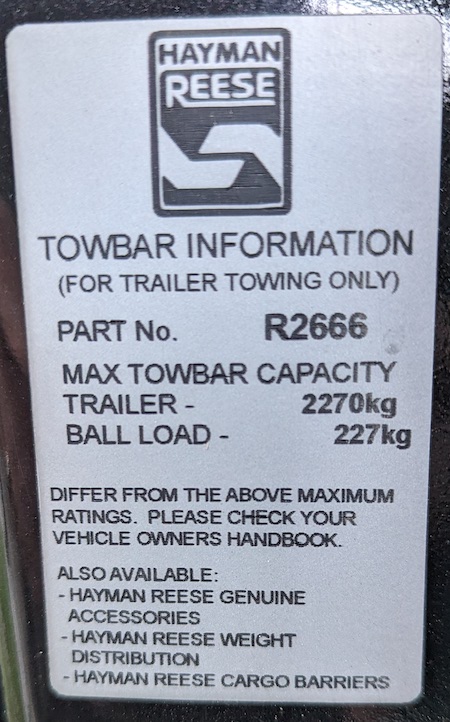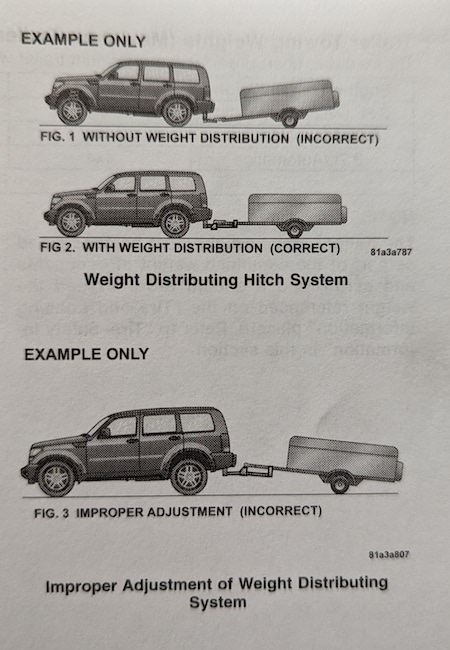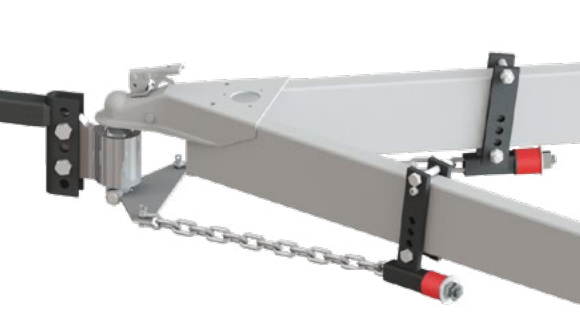How do you know what size caravan you can tow? This valuable question came to me just a few weeks ago while I was buying a new caravan.
Having looked at a bunch of caravans under my maximum towing weight for my vehicle, I found a caravan that matched everything in my list and it was in great condition. The only thing stopping me from buying right then was that I needed to be one hundred percent certain I could tow this thing and carry other essentials without overloading!
I had been travelling throughout the USA for the last ten years and over 60,000 kms, and never really had to look into the finer details of towing weights. In the USA, I have a dual rear wheeled Chevrolet 3500 which has all the towing capacity I need.
Now in Australia, I wanted to buy something to take camping with my medium size SUV, and I know there are many finer details to towing when you do not have the luxury of a big-rig hauler.
Why are weights so critical?
The number-one reason is safety. You need to be able to control your vehicle and caravan easily. If you are over any of the various weight limitations declared by your caravan and tow vehicle’s manufacturer, you will reduce the ability to safely control your rig. For one consideration: weight determines the time and distance to safely slow or stop. When you are towing anything, you need to allow more stopping time and distance. If you are overloaded or out of balance, you will need even more time and distance to stop, and your risk of a serious incident is far greater. Cornering, overtaking, downhill driving all become extremely risky in an overloaded rig.
An overweight rig can trigger a mechanical failure with dire consequences.
Where do you find your vehicle’s weight limits?
My Reese towbar was fitted by the car dealership when I bought the car. The installer placed details on the towbar and inside the driver’s door frame and there is another label located on the towbar with the same information. In my case, the maximum ATM of the trailer must be 2,270kgs or less.
The same sticker also shows the maximum allowed ball load, 227kgs. Officially known as TBM or total ball mass. Hayman Reese have designed this towbar to carry up to 227kgs as a downward force, 2,270 kgs as a horizontal force. These ratings would have been set after consultation with the vehicle manufacturer.

This label advises to check the vehicle owner’s handbook to properly comply with all weight parameters. In my case, the handbook recommends exactly the same limitations, but with several other important limits.
This is why tow vehicle weights can be confusing, and why professional support is so valuable
In researching my vehicle’s handbook, there is another section that explains exactly how much can be towed.
My manual shows I can tow a maximum of 750kgs of unbraked trailer weight. If the trailer is over 750kgs, then brakes need to be installed on the trailer, and this is a common figure on most vehicles. Above 750kgs is also the weight where road laws require brakes on any trailer, and this is fairly common knowledge too.
Caravans that weigh over 750kgs usually have brakes fitted at the factory, so this is an easy requirement to satisfy.
There is another limiting factor in my choice of caravan. The chart shows that if my particular SUV is towing a trailer or caravan of more than 1,600kgs, then a weight distribution hitch needs to be installed. This is uncommon, and shows you really need to do your research to find what you need for your towing vehicle and caravan.
A weight distribution hitch, or WDH, braces the connection between the tow vehicle and trailer right at the towball. The WDH reduces the amount of rear-axle squat on the tow vehicle, and spreads the total load of both vehicles over all the tyres including the caravan or trailer.
A WDH is not required on all SUVs and utes. A weight distribution hitch can add complications when used with D035 or other offroad type hitches, and in the case of my vehicle, the manual recommends removal of the weight distribution hitch in mild offroad situations as long as speed is not greater than 60kmh. So if I was to travel on any dirt road that is less than smooth, the weight distribution hitch should be removed. Usually 60kmh is difficult to reach on winding rough gravel anyway.
So my first assumption, taken from the Hayman Reese label, would have let me tow up to 2,270kgs, but the manufacturer of my tow vehicle declares that a weight distribution hitch is required to tow anything between 1601kgs and 2,270kgs.
What if I want an offroad caravan?
If I chose an offroad type caravan, and wanted to travel on rough ground, I would need D035 type hitch where the weight distribution hitch is not fully functional off-road. This would mean that, according to my vehicle’s owner manual, I would need to use the WDH on smooth roads, and remove the weight distribution hitch when I hit the rough ground.
The table from the owner’s manual shows that with a weight distribution hitch, my maximum trailer weight can be up to 2,270kgs and the maximum tow ball weight can be up to 227kgs.

The image shows a graphic from an owner’s handbook demonstrating the effects of a weight distribution hitch. The top image is an over-emphasised demonstration of having no distribution hitch. (The image looks really extreme and is probably poorly loaded!) The middle SUV and trailer combination is the safest because both vehicles are closest to level. The third example shows a weight distribution hitch which is over compensating and incorrectly adjusted.

The caravan I chose to purchase has a Tare weight of 1,640kgs. This is the caravan’s weight before you load anything into it. That means I need to use a weight distribution hitch at all times whether the caravan is empty or full! According to the caravan’s loading label, the maximum allowed weight with everything loaded inside this caravan is 2,080kgs, which is 190kgs less than the maximum allowed with my vehicle, so at this point, all is within limits. The calculations do not end here though!
I chose to install the Andersen weight distribution hitch. I have installed weight distribution hitches for customers, and I like the simplicity of the Andersen WDH.

(Photograph from Andersen Manufacturing Inc.)
Are we there yet?
Not so fast! There are still more compliance items to check.
The vehicle itself must be within its own maximum weight limits. After weighing this caravan accurately, the weight on the tow ball is 170kgs. So I am well inside the 227kgs tow ball weight maximum set for this vehicle and towbar. But this is 170kgs of weight added to the tow vehicle’s weight. This means that I have to confirm that the weight of the vehicle itself is within its own maximum weight in the following formula:
Tow Vehicle empty weight + Tow Ball Weight + Weight of occupants + Accessories + Food + Driver + Passengers + Luggage = Less than maximum allowed weight of the tow vehicle!
Is that the final check? Nope!
Axle loads are often overloaded too. You may have too much riding over the back axle on your towing vehicle.
Some vehicles have the front and rear ratings displayed on a label at the driver’s door, or it may be in the owner’s handbook. If it is not available, check for reliable internet information. After checking all information and you still cannot find the axle load ratings, check the front and rear axle weights on scales and ensure there is not too much of a difference between the two axles. Chances are that most of your load will be on the back axle of your towing vehicle extra items in the back seat, luggage area, and the weight of the caravan pressing down on the tow ball. If there is too much difference between the front axle weight and the rear axle weight, then you do need to either remove items from the back of your tow vehicle or if the weights allow, move things to your caravan or trailer.
We have just confirmed that our SUV is within limits with the caravan in tow, but what about the caravan?
Our twin axle (also known as tandem axle) caravan has weight maximums for each axle, each wheel, and the tow ball. We checked our caravan using our own scales and all is great because we do not need much for two or three days away. We did notice there was more weight over the back axle and chose to move a few things a little more forward to put another 30kgs on the towball for balance. We were able to show the difference on our accurate weight scales.
You can research all this on your own, or you can contact us to help you with your caravan and tow vehicle weight checks.
Do you need professional advice from Gold Coast Mobile Weigh? We can weigh each wheel of your towing vehicle and caravan or trailer. With our accurate scales, axle weights and aggregate weights are automatically calculated on the fly. This means you can shift items around in your towing vehicle and trailer or caravan and see results immediately. Phone to make a booking today! We are located in Worongary, Queensland, which is close to Nerang, Mudgeeraba, Merrimac, Robina, and many other Gold Coast neighbourhoods.
Important vehicle and caravan weight terms and meanings:
ATM: Aggregate trailer mass is the total weight of a trailer or caravan. It includes the empty weight of the trailer plus everything the trailer is carrying.
GTM: Gross trailer mass
The weight of a caravan or trailer on the axles only. If a caravan is hitched to a tow vehicle, some of the weight is carried by the vehicle’s tow ball, the rest is on the caravan’s axles. This axle weight is the GTM or gross trailer mass.
Tare:
The weight of a trailer or caravan that has nothing loaded inside, and the water storage tanks are empty. Tare does not include any accessories that may have been added since leaving the factory.
TBM: Tow ball mass
This is the weight measured at the tow ball. This weight varies depending on how much is inside the trailer or caravan and where it is located in the caravan.
GVM: Gross vehicle mass is the weight of a tow vehicle when it is fully loaded. This includes the weight pushing down on the tow ball from the trailer or TBM.
GCVM: Gross combined vehicle mass
The total weight of both tow vehicle and its caravan when hitched.
Footnote: What does ‘tare’ mean and how do you pronounce it?
Pronunciation: ‘tare’ pronounced the same as ‘tear’ as in “tear a piece of paper”, or “tear in a piece of fabric”. It is commonly pronounced as “tarry” because this can be easier to understand in general conversations.
The origin is described being adopted by the English language from ‘middle French’, an earlier version of the French language.
Meaning of tare: Tare is the weight of a totally empty vehicle. A car or ute tare would be the weight without any fuel, coolant, oil or passengers. Tare of a caravan or trailer would be the weight when it was manufactured. It should include any accessories at the time of manufacture. If you add a roof rack, or any other accessories, then theoretically you need to add the weight of accessories to tare weight. A more beneficial term is the unladen weight or kerb weight. You could simply weigh your towing vehicle when it is empty to learn the kerb weight which would include full fuel tank, oil and coolant.


Leave a Reply